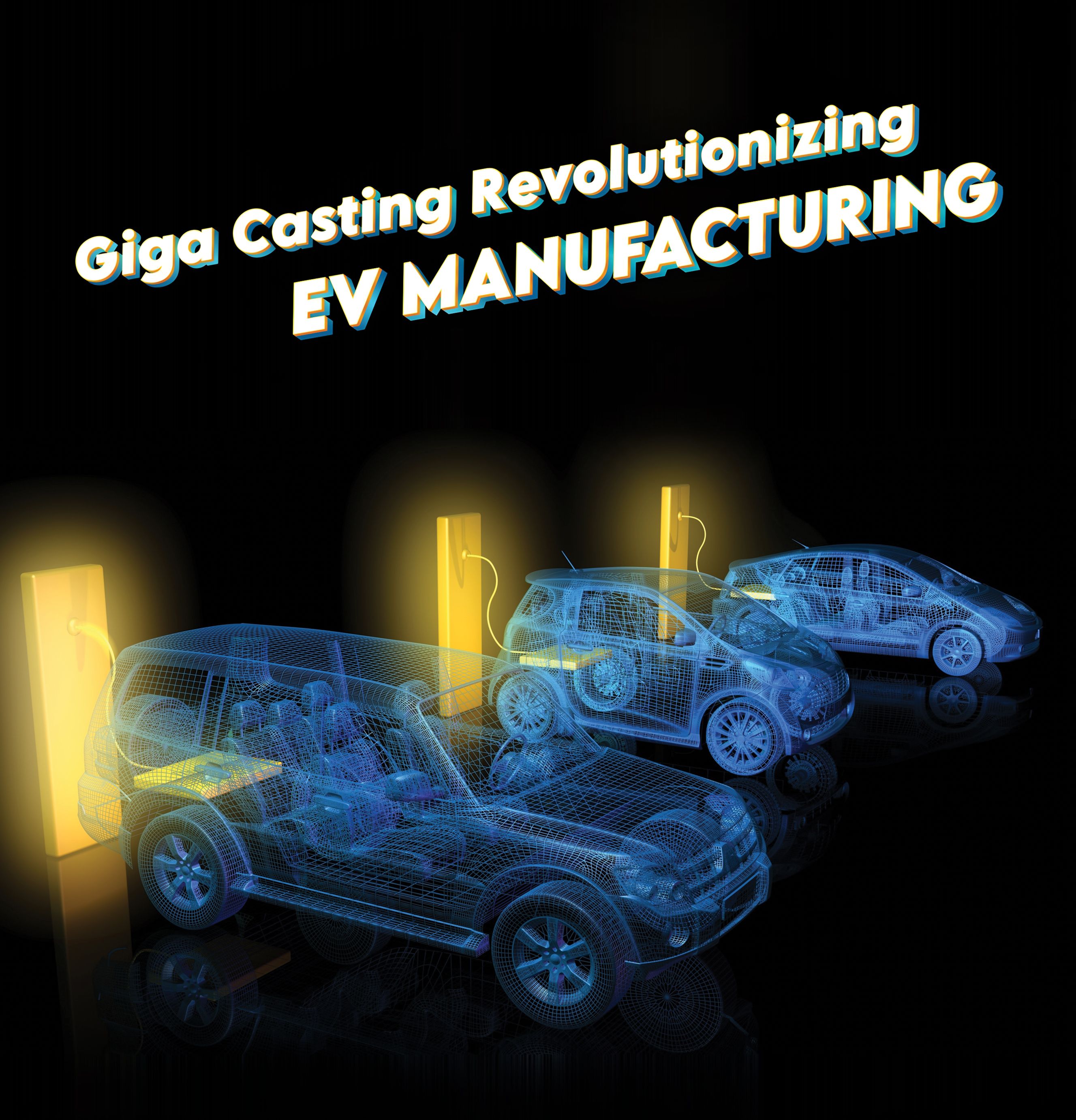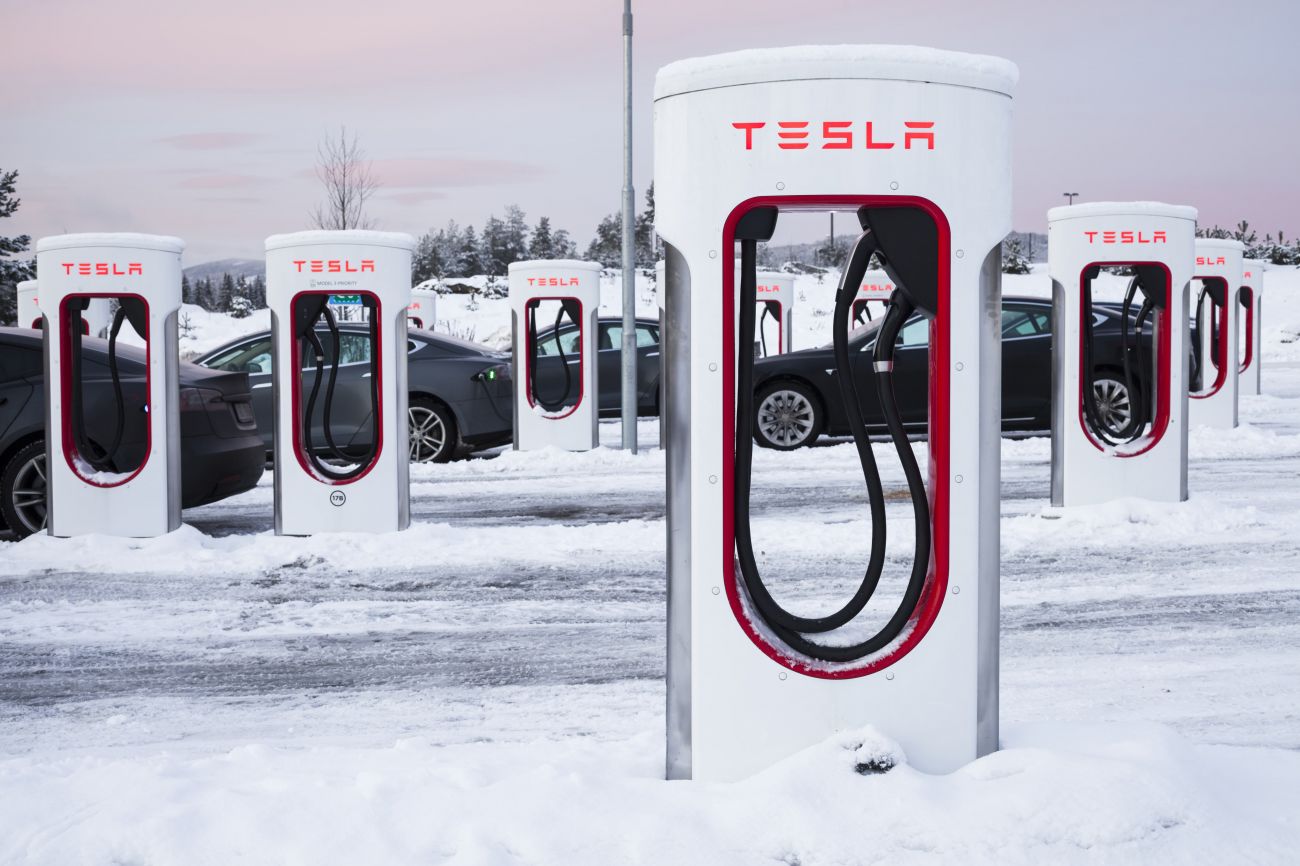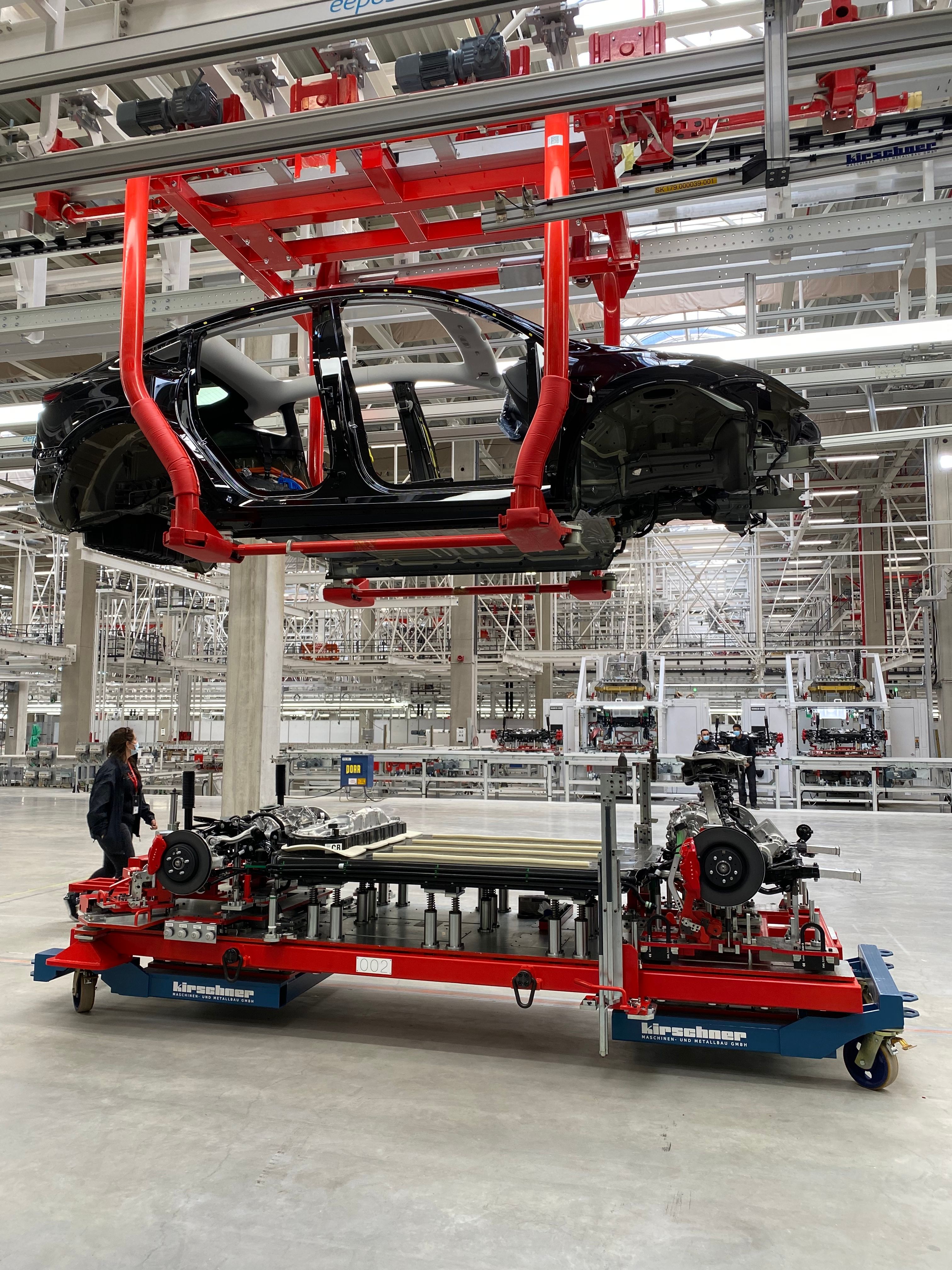GIGA CASTINGS REVOLUTIONIZING EV MANUFACTURING

Beyond its snazzy designs and impressive performance, Tesla’s manufacturing processes have been a key driver of its success. At the core of its success lies its unwavering commitment to innovation and disruption. One game-changing technology that stands out is the giga casting, which has revolutionized how car bodies are constructed.
Die casting works by forcing molten metal alloy inside a reusable mold, and then opening the mold to remove the finished piece after it cools and solidifies.
Giga Casting involves creating large vehicle components from just a few main castings. Instead of assembling numerous smaller parts, Tesla’s Giga Die Casting machines inject molten aluminum into casting molds, resulting in massive single pieces. These Giga Castings replace complex assemblies, streamlining production and significantly reducing costs.
For Tesla’s Model Y, the company utilized two giant Giga Castings that serve as the front and rear underbody, thus revolutionizing traditional car body design and streamlining manufacturing. Underbody components typically comprise about 50 percent of a vehicle’s body-in-white shell, and this soft underbelly is the target of Giga Casting’s focus.
Compared to Tesla’s earlier Model 3, these two castings replaced 171 parts, most of which were sheet stampings along with some smaller castings. This eliminated 1,600 welds and removed 300 robots from the assembly line, significantly reducing capital investment and freeing up floor space.
Traditional body-in-white stampings may become outdated S&P’s Global Mobility forecasts that 15 percent to 20 percent of traditional body-in-white stampings may be at risk of becoming obsolete by the year 2030 with automakers increasingly using Giga Castings.
These giant castings are manufactured on massive machines known as Giga Presses that can achieve 6,000 to 9,000 tonne of locking force and are capable of producing up to 45 castings per hour.
The Giga Press
Before Tesla disrupted the auto market, companies had not seriously considered using Giga Castings due to the extreme challenges involved in developing them. A few years ago, a 4,500 tonne die casting machine was considered huge. Now 9,000 tonne die casting machines are being manufactured, and 12,000 to 15,000 tonne die casting machines are also in the pipeline.
The collaboration between Italian machine maker Idra, Tesla, and the Chinese machine maker LK Technology exemplifies the power of cross-industry partnerships. LK Technology, a Chinese group that acquired Idra in 2008, played a pivotal role in the Giga Press’s development.
Liu Siong Song, Founder, LK Technology, revealed that Tesla was actively involved in the design and production of the Giga Press. For over a year, Tesla engineers worked side by side with Idra and LK Technology, refining the machine’s specifications and functionality. Engineers from the three companies constantly exchanged ideas, pushing the boundaries of what was possible. With each revision, adjustments were made to the Giga Press, ensuring it met Tesla’s exacting standards. The result was a machine capable of producing massive aluminum parts with unparalleled precision.
|
Dies for such Giga Castings are huge and can weigh up to 100 tonne. This makes die design and especially thermal management a challenge. The dies are also expensive and typically have a die life of around 1,00,000 shots when using structural alloys. |
Key features of Tesla’s Giga Presses
Size and Weight: Each Giga Press machine weighs a staggering 410-430 tonne. These massive machines are approximately 19.5 m long, 5.9 m wide, and 5.3 m tall.
Die-Casting Process: Molten aluminum, weighing around 80 kg, is injected into a cold-chamber casting mold at a velocity of 10 m per second. The entire cycle takes approximately 80-90 sec, resulting in an output of 40-45 completed castings per hour or around 1,000 castings per day.
Aluminum Melting and Preparation: Ingots and aluminum off-cuts are melted in a natural gas-powered oven, and the molten aluminum is prepared for casting.
Impurity Removal: Argon gas and a rotary degasser are used to remove impurities, ensuring high-quality castings.
Soybean Oil Separation: Before each casting cycle, robots apply a thin layer of soybean oil inside the mold halves to allow for easy separation.
Dies and molds for Giga Castings
Dies for such giant castings are also huge and can weigh up to 100 tonne. This makes die design and especially thermal management a challenge. Giga Casting dies are also expensive and typically have a die life of around 1,00,000 shots when using structural alloys. By comparison, dies for stamping presses for sheet-based components can produce up to 6 million parts over their die life.
management a challenge. Giga Casting dies are also expensive and typically have a die life of around 1,00,000 shots when using structural alloys. By comparison, dies for stamping presses for sheet-based components can produce up to 6 million parts over their die life.
Handling shot weights of 80-100 kg for each cast also requires different furnaces, material handling and transfer concepts than typical die casting centers. Many other process aspects like vacuum and die lubrication also become a lot more complicated and complex when the size of the castings is increased to Giga Casting dimensions.
3D printing Giga Casting dies and molds
3D printing plays a pivotal role in advancing Giga Casting technology. It allows intricate die and mold creation for Giga Casting machines, enabling the production of complex-shaped components. Tesla collaborated with specialized firms in
3D printing dies and molds from industrial sand and binder metals. The binder jet printer deposits a liquid binding agent on thin sand layers, following a digital design file, layer by layer, to create dies for casting molten alloys.
Many die and mold companies are now pioneering the use of 3D printed dies for Giga Casting, offering solutions capable of producing Giga Casting parts for vehicles, aircraft, and large machinery. Each 3D print takes mere hours, which means prototypes can be tweaked as many times as needed, and the cost of the entire design validation cycle is just 3 percent that of the conventional method. It also cuts the overall development time from up to a year to two or three months. Tesla has also leveraged the strength of 3D printing dies to leave hollow voids in large structural sections to reduce weight and improve crash performance.
|
The Giga Press has been a game-changer for Tesla’s manufacturing costs. For the Model Y’s rear underbody, experts estimate a remarkable 40 percent reduction in manufacturing expenses. |
Advantages of Giga Casting
Cost Reduction: The Giga Press has been a game-changer for Tesla’s manufacturing costs. For the Model Y’s rear underbody, experts estimate a remarkable 40 percent reduction in manufacturing expenses. Similarly, the Model 3 assembly line saw the removal of 600 robots, thanks to the simplified production process enabled by Giga Castings.
Lightweighting: Electric vehicle batteries are heavy, and manufacturers seek ways to offset this weight elsewhere. Giga Casting not only reduces the number of individual parts but also contributes to overall weight reduction. By eliminating dozens of smaller components, Tesla achieves a double benefit – cost savings and improved energy efficiency.
Environmental Impact: Fewer parts mean fewer manufacturing steps, which translates to reduced energy consumption and lower carbon emissions. Tesla’s commitment to sustainability aligns perfectly with the Giga Casting approach. As the Automotive industry transitions toward cleaner technologies, innovations like Giga Castings will play a crucial role in minimizing environmental impact.
Potential downsides
Many in the Auto industry are of the view that despite the various advantages, there are also disadvantages to Giga Castings that need to be considered.
One of the big disadvantages is repairability. With an assembly involving multiple pieces, a mechanic can simply remove and replace the damaged or defective part. However, with a Giga Casting, the entire casting would have to be replaced, which would be prohibitively expensive.
The second downside is the challenge of maintaining the tight tolerances required during manufacturing. Giga Castings have different wall thicknesses throughout the part, each of which cools down differently within the die during the cooling and subsequent quenching phases. This leads to distortions that are often difficult to simulate and predict precisely. Therefore, there are still several unknown elements in the deviations and variations of tolerances in Giga Castings compared to sheet metal assembly processes.
In addition, Giga Castings are not joined to other parts using standard spot-welding procedures but rather use other methods that can also cause unexpected or unknown geometrical variations.
|
According to S&P’s Global Mobility report, the production of light electric vehicles in mainland China is expected to reach a total of 19 million units annually by 2030, firmly establishing the country as a global leader in the EV sector. |
Other automakers follow suit
Despite the potential disadvantages, Tesla’s success with Giga Casting has inspired other automakers to follow suit. A host of automakers like GM, Mercedes-Benz, Volkswagen, Toyota, Hyundai, Ford, Volvo, and Chinese electric vehicles companies like Geely, Nio,
and Xpeng are now emulating Tesla’s Giga Casting know-how to match its design and manufacturing efficiency and avoid being undercut in a competitive market.
China is looking to exert a substantial influence in Giga Castings globally. China is now the world’s largest automotive and electric vehicle market. Sales of electric cars sold in China accounted for 60 percent of the global sales of EVs in 2023. According to S&P’s Global Mobility report, the production of light electric vehicles in mainland China is expected to reach a total of 19 million units annually by 2030, firmly establishing the country as a global leader in the EV sector. According to Bloomberg, there are a staggering 129 EV brands in China, but just 20 have managed to achieve a domestic market share of one percent or more.
Tesla’s relentless pursuit of innovation has reshaped the Automotive industry. The Giga Casting process exemplifies how bold ideas can lead to tangible benefits—lower costs, lighter vehicles, and a greener future. As other manufacturers embrace this technology, we can expect even more exciting developments in the world of electric mobility.
 |
Reji Varghese MD RV Forms & Gears fngreji@gmail.com |



 Facebook
Facebook.png) Twitter
Twitter Linkedin
Linkedin Subscribe
Subscribe